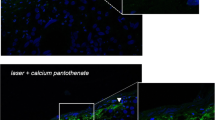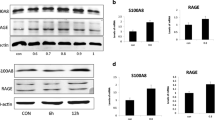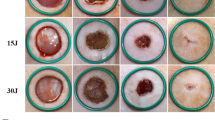Abstract
Glycyl-l-histidyl-l-lysyl (GHK) possesses a high affinity for copper(II) ions, with which it spontaneously forms a complex (copper–GHK). It is well known that copper–GHK plays a physiological role in the process of wound healing and tissue repair by stimulating collagen synthesis in fibroblasts. This study was conducted to investigate the effects of copper–GHK on keratinocytes. Proliferative effects were analyzed and hematoxylin and eosin staining and immunohistochemistry were conducted to evaluate the effects of copper–GHK in skin equivalent (SE) models. In addition, western blotting was performed. In monolayer cultured keratinocytes, copper–GHK increased the proliferation of keratinocytes. When the SE models were evaluated, basal cells became cuboidal when copper–GHK was added. Immunohistochemical analysis revealed that copper–GHK increased proliferating cell nuclear antigen (PCNA) and p63 positivity. Furthermore, the expression of integrin α6 and β1 increased in SE models, and these results were confirmed by Western blotting. The results of this study indicate that treatment with copper–GHK may increase the proliferative potential of basal keratinocytes by modulating the expression of integrins, p63 and PCNA. In addition, increased levels of p63, a putative stem cell marker of the skin, suggests that copper–GHK promotes the survival of basal stem cells in the skin.





Similar content being viewed by others
References
Bell E, Ivarsson B, Merrill C (1979) Production of a tissue-like structure by contraction of collagen lattices by human fibroblasts of different proliferative potential in vitro. Proc Natl Acad Sci USA 76:1274–1278. doi:10.1073/pnas.76.3.1274
Canapp SO Jr, Farese JP, Schultz GS, Gowda S, Ishak AM, Swaim SF, Vangilder J, Lee-Ambrose L, Martin FG (2003) The effect of topical tripeptide–copper complex on healing of ischemic open wounds. Vet Surg 32:515–523. doi:10.1111/j.1532-950X.2003.00515.x
Carroll DK, Carroll JS, Leong CO, Cheng F, Brown M, Mills AA, Brugge JS, Ellisen LW (2006) p63 regulates an adhesion programme and cell survival in epithelial cells. Nat Cell Biol 8:551–561. doi:10.1038/ncb1420
Grose R, Hutter C, Bloch W, Thorey I, Watt FM, Fassler R, Brakebusch C, Werner SA (2002) Crucial role of beta 1 integrins for keratinocyte migration in vitro and during cutaneous wound repair. Development 129:2303–2315
Ivanova IA, D’Souza SJ, Dagnino L (2005) Signalling in the epidermis: the E2F cell cycle regulatory pathway in epidermal morphogenesis, regeneration and transformation. Int J Biol Sci 1:87–95
Kamoun A, Landeau JM, Godeau G, Wallach J, Duchesnay A, Pellat B, Hornebeck W (1995) Growth stimulation of human skin fibroblasts by elastin-derived peptides. Cell Adhes Commun 3:273–281. doi:10.3109/15419069509081013
Kim DS, Cho HJ, Choi HR, Kwon SB, Park KC (2004) Isolation of human epidermal stem cells by adherence and the reconstruction of skin equivalents. Cell Mol Life Sci 61:2774–2781. doi:10.1007/s00018-004-4288-4
Kim SW, Lee IW, Cho HJ, Cho KH, Kim KH, Chung JH, Song PI, Park KC (2002) Fibroblasts and ascorbate regulate epidermalization in reconstructed human epidermis. J Dermatol Sci 30:215–223. doi:10.1016/S0923-1811(02)00108-1
Li A, Simmons PJ, Kaur P (1998) Identification and isolation of candidate human keratinocyte stem cells based on cell surface phenotype. Proc Natl Acad Sci USA 95:3902–3907. doi:10.1073/pnas.95.7.3902
Maquart FX, Bellon G, Chaqour B, Wegrowski J, Patt LM, Trachy RE, Monboisse JC, Chastang F, Birembaut P, Gillery P et al (1993) In vivo stimulation of connective tissue accumulation by the tripeptide-copper complex glycyl-l-histidyl-l-lysine-Cu2+ in rat experimental wounds. J Clin Invest 92:2368–2376. doi:10.1172/JCI116842
Maquart FX, Pickart L, Laurent M, Gillery P, Monboisse JC, Borel JP (1988) Stimulation of collagen synthesis in fibroblast cultures by the tripeptide–copper complex glycyl-l-histidyl-l-lysine-Cu2+. FEBS Lett 238:343–346. doi:10.1016/0014-5793(88)80509-X
Park KC, Choi HR, Cho HJ, Kim SK, Kwon SB, Kim DS, Cho YJ, Youn SW (2004) Effects of ascorbic acid on keratinocyte and epidermalization of skin. Ann Dermatol 16:45–51
Pickart L (2008) The human tri-peptide GHK and tissue remodeling. J Biomater Sci Polym Ed 19:969–988. doi:10.1163/156856208784909435
Pickart L, Thaler MM (1973) Tripeptide in human serum which prolongs survival of normal liver cells and stimulates growth in neoplastic liver. Nat New Biol 243:85–87
Pollard JD, Quan S, Kang T, Koch RJ (2005) Effects of copper tripeptide on the growth and expression of growth factors by normal and irradiated fibroblasts. Arch Facial Plast Surg 7:27–31. doi:10.1001/archfaci.7.1.27
Rheinwald JG, Green H (1975) Serial cultivation of strains of human epidermal keratinocytes: the formation of keratinizing colonies from single cells. Cell 6:331–343. doi:10.1016/S0092-8674(75)80001-8
Rodius S, Indra G, Thibault C, Pfister V, Georges-Labouesse E (2007) Loss of alpha6 integrins in keratinocytes leads to an increase in TGFbeta and AP1 signaling and in expression of differentiation genes. J Cell Physiol 212:439–449. doi:10.1002/jcp.21040
Russell AJ, Fincher EF, Millman L, Smith R, Vela V, Waterman EA, Dey CN, Guide S, Weaver VM, Marinkovich MP (2003) Alpha 6 beta 4 integrin regulates keratinocyte chemotaxis through differential GTPase activation and antagonism of alpha 3 beta 1 integrin. J Cell Sci 116:3543–3556. doi:10.1242/jcs.00663
Simeon A, Monier F, Emonard H, Gillery P, Birembaut P, Hornebeck W, Maquart FX (1999) Expression and activation of matrix metalloproteinases in wounds: modulation by the tripeptide-copper complex glycyl-l-histidyl-l-lysine-Cu2+. J Invest Dermatol 112:957–964. doi:10.1046/j.1523-1747.1999.00606.x
Simeon A, Wegrowski Y, Bontemps Y, Maquart FX (2000) Expression of glycosaminoglycans and small proteoglycans in wounds: modulation by the tripeptide-copper complex glycyl-l-histidyl-l-lysine-Cu(2+). J Invest Dermatol 115:962–968. doi:10.1046/j.1523-1747.2000.00166.x
Sonnenberg A, Calafat J, Janssen H, Daams H, van der Raaij-Helmer LM, Falcioni R, Kennel SJ, Aplin JD, Baker J, Loizidou M et al (1991) Integrin alpha 6/beta 4 complex is located in hemidesmosomes, suggesting a major role in epidermal cell-basement membrane adhesion. J Cell Biol 113:907–917. doi:10.1083/jcb.113.4.907
Tenaud I, Sainte-Marie I, Jumbou O, Litoux P, Dreno B (1999) In vitro modulation of keratinocyte wound healing integrins by zinc, copper and manganese. Br J Dermatol 140:26–34. doi:10.1046/j.1365-2133.1999.02603.x
Tiberio R, Marconi A, Fila C, Fumelli C, Pignatti M, Krajewski S, Giannetti A, Reed JC, Pincelli C (2002) Keratinocytes enriched for stem cells are protected from anoikis via an integrin signaling pathway in a Bcl-2 dependent manner. FEBS Lett 524:139–144. doi:10.1016/S0014-5793(02)03040-5
Wegrowski Y, Maquart FX, Borel JP (1992) Stimulation of sulfated glycosaminoglycan synthesis by the tripeptide–copper complex glycyl-l-histidyl-l-lysine-Cu2+. Life Sci 51:1049–1056. doi:10.1016/0024-3205(92)90504-I
Yang A, Schweitzer R, Sun D, Kaghad M, Walker N, Bronson RT, Tabin C, Sharpe A, Caput D, Crum C, McKeon F (1999) p63 is essential for regenerative proliferation in limb, craniofacial and epithelial development. Nature 398:714–718. doi:10.1038/19539
Acknowledgments
This study was supported by a grant (A050432) from the Korea Health 21 R&D Project, Ministry of Health and Welfare.
Author information
Authors and Affiliations
Corresponding author
Rights and permissions
About this article
Cite this article
Kang, YA., Choi, HR., Na, JI. et al. Copper–GHK increases integrin expression and p63 positivity by keratinocytes. Arch Dermatol Res 301, 301–306 (2009). https://doi.org/10.1007/s00403-009-0942-x
Received:
Revised:
Accepted:
Published:
Issue Date:
DOI: https://doi.org/10.1007/s00403-009-0942-x




